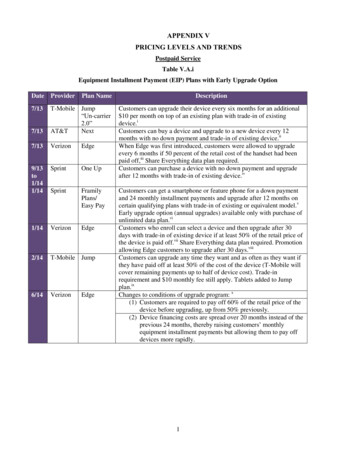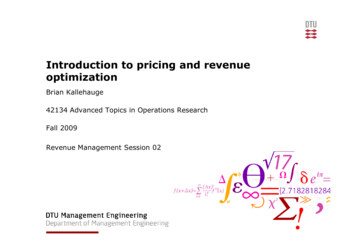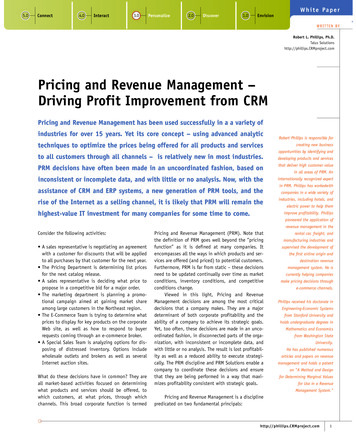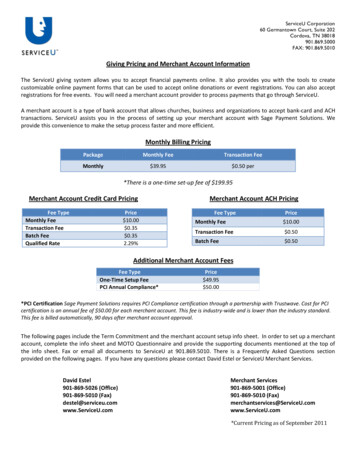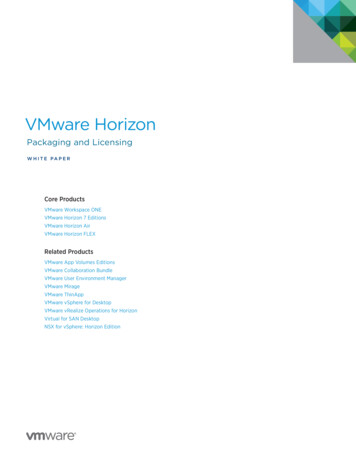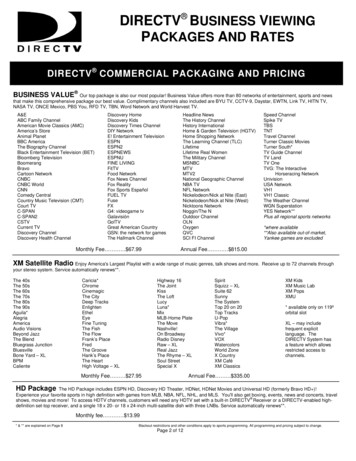
Transcription
Pricing andProfitabilityManagementA Practical Guide forBusiness LeadersJulie M. MeehanMichael G. SimonettoLarry Montan, Jr.Christopher A. Goodin
FTOC02/22/201112:41:10Page 7Table of ContentsForewordxiList of ContributorsChapter 1xvIntroduction to Pricing and ProfitabilityManagement1Pricing: The Critical Lever for Raising Performance2Common Obstacles to Pricing andProfitability Management5Understanding—and Leveraging—the HumanSide of Pricing9An Integrated Approach to Pricing: TheSix Core CompetenciesChapter 2Chapter 311Beginning the Journey: Key Questions to Ask17Endnotes22Conducting a Pricing and ProfitabilityDiagnostic23The Case for a Diagnostic24How to Execute a Diagnostic26Consolidating Findings and IdentifyingOpportunities to Improve Capabilities34Challenges and Considerations41Developing an Effective Pricing Strategy43What Comprises a Successful Pricing Strategy?44How to Make Value Your Focus—and Why47Formulating a Value-Based Pricing Strategy50Designing and Integrating an EffectivePricing Structure71vii
FTOC02/22/2011viii12:41:10Page 8Table of ContentsChapter 4Identifying and Using the PrincipalPricing Archetypes75Critical Challenges Faced by Pricing Strategists85Tips for Moving Forward88Endnotes89Price Execution91What Is Price Execution?92Using the Best Practice Pricing Process Framework93Setting Policies to Reinforce Pricing ProcessesChapter 5Chapter 6125Tips for Moving Forward136Endnotes138Advanced Analytics and Price Setting139Building a Transaction-Level Data Set140Conducting Transactional ProfitabilityAssessments142Integrating Cluster Analyses to SegmentCustomers, Products, and Services165Assessing the Competition: ValueEquivalency Analytics166Demand-Based Optimization Modelingto Improve Price Setting170Tips for Moving Forward182Endnotes183Achieving Effective OrganizationalAlignment and Governance185Five Key Components for Aligning aPricing Organization186Aligning Sales to Support Pricing andProfitability Goals187Identifying and Empowering Pricing Leaders194Designing Robust Organizational andGovernance Structures199Implementing Change Management andAdoption Processes206Evaluating and Managing Pricing Talent217Making the Organizational Commitmentto Change225Endnotes226
FTOC02/22/201112:41:10Chapter 7Chapter 8Chapter 9AppendixIndexPage 9Table of ContentsixPricing Technology and Data Management227What Is Pricing Software?228The History of the Pricing Software Market233Building a Business Case for Pricing Technology238Selecting Pricing Management Software247The Pricing Software Development Life Cycle252Future Trends in Pricing Technology256Pricing Technology Selection andImplementation Recommendations258Endnotes259Integrating Tax and Regulatory Policieswith the Pricing Strategy261The Convergence of Tax and Pricing Strategy263How to Integrate Pricing and TaxFunctions—and Why266Managing Pricing and Compliance Coststo Maximize Returns280Navigating Regulatory Environments WhenMaking Pricing Decisions283Where to Go from Here?285Endnotes287Pricing as a Sustainable CompetitiveAdvantage289Why Taking a Holistic Approach to Pricing Matters289Bringing it All Together: A Case Study291Emerging Trends in Pricing andProfitability Management298Lessons Learned: Getting Pricing on theExecutive Agenda302What Is Value and Why Is It So Difficultto Measure?305Endnotes308309
C0102/21/20118:55:1Page 11C H A P T E RIntroduction to Pricing andProfitability ManagementThe moment you make a mistake in pricing, you’re eating into yourreputation or your profits.—Katie Paine, founder and CEO of KDPaine & PartnersThere is an old joke about a businessman who loses margin every timehe sells his products. A customer asks, ‘‘How do you make money?’’ Thebusinessman answers, ‘‘I make it up in volume.’’A company that routinely sells products below its margins wouldhardly seem likely to remain in business for long. Nonetheless, many firmsfollow this approach today. In some cases, this approach is an unintentional move, which results in the company’s losing money on everytransaction. In other cases, it reflects a carefully considered decision tomaximize profitability across a portfolio of product offerings. However,in other instances, this approach is adopted by business leaders whosimply misunderstand which of their products and customers are actuallygenerating margin and the factors that truly determine their company’sprofitability.The field of pricing management has been growing steadily in recentyears. If you mention the subject in a group, many people will assume theensuing discussion will be limited to price setting. But the disciplineinvolves much more than just prices themselves. Pricing management is astrategic competency that involves people, processes, technology, andinformation. Its reach extends into virtually every corner of an organization (i.e., marketing, sales, IT, operations, finance, accounting, and executive leadership). Effective pricing management is capable of changing theway a company views and operates its entire business; it helps ensure the1
C0102/21/201128:55:1Page 2Pricing and Profitability Managementoverall profitability of an enterprise and it can impact the bottom line profoundly. This book is intended to serve as a comprehensive introduction tothe discipline and a reference work for business leaders, managers, andstudents who want to deepen their understanding of and sharpen theircapabilities in this critical function.Pricing: The Critical Lever for Raising PerformanceWhy make pricing improvement a focus for an organization? The answer issimple: the benefits are enormous. A study has shown that 90 percent ofpricing investment meets or exceeds return on investment (ROI) expectations.1 Put another way, for any dollar invested in performance improvement,the greatest return comes when it is invested in pricing.Figure 1.1 reflects one version of an often-replicated analysis.2 Allversions lead to the same conclusion: pricing is the most powerful leveravailable to raise performance. Despite this, the evolution of pricing management has, until recently, been slow. Although it has long been recognized as one of the traditional four P’s of marketing, a number of systemicand structural challenges prevented pricing management from achievingthe same level of sophistication or having the same capacity to improveperformance as it has now. In its early days, practitioners focused on revenue/yield management and operated almost exclusively in the airline andhospitality industries. But recent developments have led companies toappreciate the breadth and critical importance of the discipline. We discuss three of these developments briefly below.The Search for Improved Data Management SolutionsThe widespread adoption of enterprise resource planning (ERP), particularly over the past 10 years, has enabled firms to collect, process, and storeFigure 1.1 Profit Improvement Initiatives and Return onInvestment (ROI)
C0102/21/20118:55:2Page 3IntroductionFigure 1.23Causes of Historical Growth of the Pricing Disciplinemore transaction-level data than ever before—a prerequisite for effectivepricing management. However, management of this information haslagged behind. Data mining, transaction-level price analyses, demandelasticity curves, price waterfalls, price-band analysis, customer segmentation, and transaction-level profitability measurement are all tools thatrequire large amounts of clean, available data. Companies have aggressively sought new ways to manage this data, which, in turn, has led to anexplosion in price optimization software (Fig. 1.2).Traditionally, pricing software addressed demand curves, price optimization, and, at the highest level of sophistication, revenue/yield management. In the past five to seven years, however, the need for software toaddress price execution has been recognized and addressed. The softwarecontinues to evolve in response to market needs, as various packagesleapfrog each other with improved capabilities. Overall, vendors havemoved from offering purely custom solutions to providing true ‘‘off-theshelf’’ functionality that can be implemented in months, not years. In addition, these vendors aggressively pursue the integration of stand-alonepricing software and core ERP systems.
C0102/21/201148:55:2Page 4Pricing and Profitability ManagementThe response to these software developments has been striking. Everysingle competitor in the ERP space has bought or built software, or partnered with other vendors who have software, to bring advanced pricingcapabilities to the market. This is true for both the business-to-businessand the business-to-consumer markets.As this book was going to press in 2010, the pricing software industrywas well into a consolidation phase. A number of the small niche playershad gone out of business or been absorbed by larger firms who covetedthe specific capabilities they could add to their existing application portfolio. A few key players had emerged, but the true winners had not yetachieved dominance.However, despite its obvious importance, software alone will not provide a competitive price advantage; good data can only serve as a basisfor developing an effective strategy. In fact, if software is positioned as the‘‘silver bullet,’’ it can actually decrease a company’s ability to set and manage prices because sales personnel will likely resist using the tool withoutcareful preparation. For example, an advanced software application canhelp calculate customer-specific pricing, but if sales incentives are notaligned with the new prices, then discounting practices may arise thatundermine them and make the new price list suboptimal. For this reasonand many others, software must be part of a comprehensive strategy thatcan meet the demands of an increasingly complex world.The Growing Challenges of Global MarketsGlobalization (and the expansion of cross-border arbitrage and graymarket activity) has increased the need for multinational companiesto create worldwide pricing strategies. If not addressed effectively, graymarkets will cannibalize sales for manufacturers and jeopardize relationships with distributors who own contractual rights within a region.The need to address these issues strategically in international marketswill continue to grow as companies realize other profitability initiativeshave ceased to work.Reaching the Limits of Cost-CuttingAn organization can only undertake so many cost-reduction initiativeswithout diminishing its ability to serve its customers effectively. For example, a manufacturing company can consolidate plants to slash expensesonly so long as its production capacity is still able to meet demand. Similarly, a retailer cannot continue eliminating sales personnel if this strategyinterferes with the running of the store, causing revenue to drop. Companies can never ‘‘cut’’ their way to prosperity. Pricing, in contrast, is a constant means to profitable growth.The emergence of these three trends—improved data managementsolutions, the challenges of global markets, and the limits of cost-cutting—
C0102/21/20118:55:2Page 5Introduction5has helped companies see the tremendous opportunities that pricing management can produce. The benefits are both sizeable and quickly realized.(There is also a first mover advantage: the earlier a firm addresses pricing,the further along its learning curve and ahead of the competition itwill be.) Yet while companies have more and more tools available to helpthem develop an improved pricing capability, many still have failed toact. Why?Common Obstacles to Pricing andProfitability ManagementIn a 2004 study, AMR Research found that fewer than 3 percent of companies effectively managed, communicated, and enforced prices.3 Why?Because pricing, done correctly, is an extremely complex undertaking thatrequires a group of trained practitioners to view the business through aunique lens.While executives may understand the benefits of improving their organizations’ capabilities, the obstacles they face may seem insurmountableand can create institutional inertia. Many apparent barriers simply reflectthe demands of pricing management itself. Other barriers reflect thenatural confusion of an organization that lacks the structure and thepersonnel to handle the new strategic approach. A few of the commonimpediments follow.Daunting ComplexityPricing is an intricate and interdependent competency that impacts alllevels of an organization and the market it serves (including customersand competitors). At any given time, an organization must ask itself andaddress a multitude of questions: How can price be used as a competitive advantage, and how can weachieve results as quickly as possible? How do we position a price with our customers, and how do we dif-ferentiate our offering? What should our value propositions be for each customer segment? How does our product portfolio match the needs of our customers? What do we have to do to meet the promises made by our executivesand our sales force, while still delivering the required margin? Can we use price to influence demand (and can we build that intoour production and supply chain thinking)? What should our price be? Once we have the right price in place, how do we execute iteffectively, and what will be the likely customer and competitorresponses?
C0102/21/201168:55:2Page 6Pricing and Profitability ManagementInternal ResistancePricing data collection and cleansing can be a challenging and time-consuming task that requires specialized technical skills and a cross-functionaland multisystem understanding of the data. Winning cooperation betweenthe different functional groups involved may prove difficult. Initial improvement efforts are often viewed skeptically by organizations simply because they reflect a new approach. In addition, individual units may rely ondifferent data sets to form their assessments of the organization’s needsand market position, which can lead to strategic di
pricing software and core ERP systems. Figure 1.2 Causes of Historical Growth of the Pricing Discipline Introduction 3. C01 02/21/2011 8:55:2 Page 4 The response to these software developments has been striking. Every single competitor in the ERP space has bought or built software, or part-nered with other vendors who have software, to bring advanced pricing capabilities to the market. This is .


